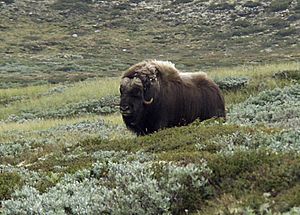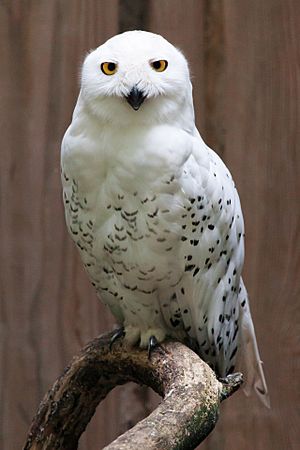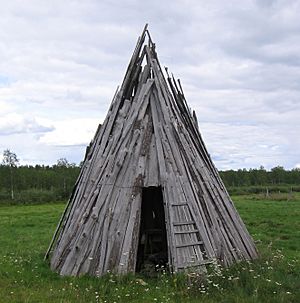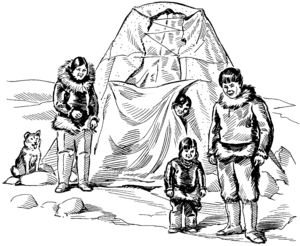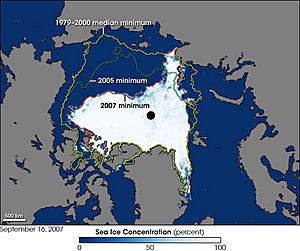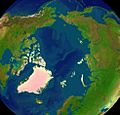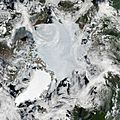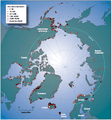Arctic facts for kids
The Arctic is the area around the Earth's North Pole. The Arctic includes parts of Russia, Alaska, Canada, Greenland, Lapland and Svalbard as well as the Arctic Ocean. It is an ocean, mostly covered with ice. Most scientists call the area north of the treeline Arctic. Trees will not grow when the temperatures get too cold. The forests of the continents stop when they get too far north or too high up a mountain. (Higher places are colder, too.) The place where in the trees stop is called the tree line.
The area north of the treeline is not an empty ice field. In fact, the only large ice-covered land is central Greenland, which is covered year-round by a continental glacier. The land of the Arctic is around the edges of the Arctic Circle and is usually covered with tundra. A tundra is a cold, almost treeless plain covered with moss and grasslike plants called sedges.
Tundras do not get very much rain or snow. However, they are very wet in the summer time because, three feet (1m) or so below the surface, the ground is always frozen. This permafrost is a layer of ice with the hardness of stone that keeps water from soaking into the earth beneath it. Permafrost can be thousands of feet thick. In the summer the ground on top thaws out when the sun shines and the snow that did fall melts. But the melted snow cannot drain into the ground; it just soaks the topsoil. There is no place for the water to go, except to form lakes and puddles on top of the ground until it freezes again or dries up.
In the Arctic, during summer there are nights when the Sun never sets. This is because during summer there, the North Pole points toward the Sun. So, sometimes people call it the Land of the Midnight Sun.
The word comes from the Greek word αρκτος, meaning "bear". The North Pole aims at the stars called the Great Bear and the Little Bear. This is why it is called the Arctic.
Contents
Climate
The Arctic is characterized by cold winters and cool summers. Its precipitation mostly comes in the form of snow and is low, with most of the area receiving less than 50 cm (20 in). High winds often stir up snow, creating the illusion of continuous snowfall. Average winter temperatures can go as low as −40 °C (−40 °F), and the coldest recorded temperature is approximately −68 °C (−90 °F). Coastal Arctic climates are moderated by oceanic influences, having generally warmer temperatures and heavier snowfalls than the colder and drier interior areas. The Arctic is affected by current global warming, leading to Arctic sea ice shrinkage, diminished ice in the Greenland ice sheet, and Arctic methane release as the permafrost thaws. The melting of Greenland's ice sheet is linked to polar amplification.
Due to the poleward migration of the planet's isotherms (about 56 km (35 mi) per decade during the past 30 years as a consequence of global warming), the Arctic region (as defined by tree line and temperature) is currently shrinking. Perhaps the most alarming result of this is Arctic sea ice shrinkage. There is a large variance in predictions of Arctic sea ice loss, with models showing near-complete to complete loss in September from 2035 to some time around 2067.
Plant life
In some parts of the Arctic the ground is covered with bright-colored flowers during the short summer. These little plants have very short stems. They must stay close to the ground, because the earth is warmer than the biting winds that blow above it. Even some rocks have plants growing on them. These rock plants are called lichens. Lichens will grow on the bare rocks. Yellow reindeer moss is really a lichen. It grows slowly, but often grows over six inches (15 cm) tall. It is spongy and full of water. This plant is the summer food for reindeer.
Trees are rare on the tundra. Only in the protected valleys or along the riverbanks are small trees able to grow. Rivers come into the Arctic from the warmer south. The places along their banks are a little bit warmer than the rest of the tundra, and trees can grow there. Otherwise only a few clusters of bushes grow sparingly. Berries are the only fruit that grows in the Arctic.
Each summer the ice and snow melt, allowing the animals to find food and the plants to flower. The moisture from the snow stays toward the top of the ground's surface. Plant roots can use it for their growth. Even so, in many places the soil is too poor for plant's growth. Less than half of the tundra has plants growing on it.
Animal life
The polar bear is the world's largest meat-eating land animal. Polar bears are well adapted to hunt seals out on the ice. They are excellent swimmers, and the coldest water does not bother them. They wait by breathing holes if they pick up the scent of a seal. They can also break through the ice at thin areas. Sometimes they can sneak up on a sleeping seal. They have a very strong sense of smell, which they use to find prey out on the ice. Polar bears get most of their food when there is pack ice. They must eat and store fat before the ice is gone: they cannot catch seals in open water. After mating, females dig themselves into a den of snow on land for the rest of the winter. There, they have their cubs, usually twins. Bears usually eat fish, birds' eggs, seaweed, and dead whales, but they would rather have a meal of seal or walrus.
The Arctic fox often trails the bears onto the ice to eat their leftover food. The fox also eats rabbits, lemmings, and voles. The lemmings and voles are the rats and mice of the Arctic. The lemmings have very short tails. They live underground in summer. Because the top soil freezes in the winter, they cannot burrow underground then, so they live under the snow during the colder months. They eat plants and roots. In a year with plenty of food, millions of lemmings will be roaming the tundra. The owls and foxes have more food than they can eat. They will have more young in years when there are many lemmings. However, the tundra does not have enough food for millions of lemmings. They rush across the tundra looking for food, and are eaten by predators or starve to death. Some try to swim across lakes or rivers and drown. The few that remain continue to have families.
Caribou and their relative, the reindeer, also live in the Arctic. The caribou are now found mostly in North America, and they are larger than the reindeer. Large herds feed on the grass and lichens. When fall comes, they move south to winter feeding grounds. They dig through the snow with their sharp hoofs for food. Their hollow fur creates a cushion of air around them that helps them to stay warm. In the spring they return north to the summer pastures, where their calves are born. An hour or so after being born, the calves are able to follow the herd toward the Arctic Ocean. Most of the world's reindeer live in Europe and Asia. Some of these reindeer are not wild. They have been tamed by herdsmen who protect them from wolves and lead the migrations each spring and fall. Also, the musk ox, which looks like a shaggy buffalo, lives in the Arctic.
In summer, many birds visit the Arctic, and most of them are water birds, such as geese, ducks, swans, loons, and Arctic terns. Flying in for the summer, they raise their young and return south for the winter. The snowy owl and the ptarmigan stay all year. The color of the snowy owl matches the snow. The ptarmigan's summer plumage changes to white when it gets colder.
The smallest animals of the Arctic are the flies and the mosquitoes. Thick swarms bite both men and animals in the summer. The reindeer try to escape the mosquitoes by running to higher pastures, but the only real help comes with the snow and cold, when the swarms die off for another season.
Human life
One of the surprises of the Arctic is that many people live there. Some people have lived there for thousands of years. Eskimo and Lapp (Sami) people lived in the Arctic long before electric heaters, snow-mobiles, and modern houses.
Other North indigenous peoples include the Inuit, Chukchi, Evenks, Iñupiat, Khanty, Koryaks, Nenets, Yukaghir, Gwich'in, and Yupik.
The Lapps
In an extremely northern part of Europe there is a place called Lapland. It is not a country, but parts of four countries. The people who lived there are called Lapps by outsiders. They call themselves Sami. The Lapps of these four countries lived there long before the countries of Northway, Sweden, Finland, and Russia were created. There were several kinds of Lapp people. Some lived by the ocean and lived mostly on fish. Another group lived along the warmer rivers. These people did a little farming, hunting, and fishing to live.
But the best known of the Lapp people were the nomads who raised reindeer. The Lapps survived in their harsh homeland by domesticating the reindeer. The Lapps were able to get everything they needed from the deer. They ate mostly meat, milk, and cheese. Their clothes were made from reindeer skins and wool. Their tents were also made from deer skins. They are known for the beautifully decorated woolen clothing they made.
The Lapps protected the herds, moving with them as they migrated from summer to winter pastures. They used trained reindeer to pull sleds carrying their supplies. During the winter, the herds moved south of the treeline. The Lapps would live nearby in homes made of logs or sod. The Lapps were very careful not to waste anything they got from the reindeer. Milk was taken from the reindeer to drink or make cheese. Meat was taken for food. The blood was frozen in chunks and used for soup and pancakes. Knives and belt buckles were carved from the bones and antlers. The sinews were used as sewing thread. Cleaned-out stomachs were used to carry milk or cheese. Every part of a dead reindeer was used.
Winter clothing was made from layers of deer skin. The inside layer would be worn with the fur facing in toward the person's skin. The second layer was worn with the fur facing out. Boots were also made of fur, lined with grass that had been gathered during the short summer. Every evening the grass would be taken out and dried by the fire, so it would be ready to use again the next day. Thus, a Lapp could be warm and comfortable in even the coldest weather.
Today only a few of the Lapp people still follow the herds. Those few use modern tools on their ancient migration. They use snowmobiles to herd the reindeer and rifles to kill the wolves that chase them. Even helicopters and radios are used to locate and move the reindeer. Most of the Lapp people now live on small farms in one of the four nations of Lapland. They raise crops and animals, including a few reindeer, to meet their needs. The sale of reindeer meat is an important source of income for the Lapp people.
Eskimos
Eskimos are Arctic people, too. They sometimes ate raw meat. Eskimos were also nomads, but they did not have any animals except for dogs, which they used for pulling their sleds and helping them hunt. They were hunters and gatherers, and they lived off on whatever they found or hunted. Like the Lapps, though, they were very careful to make good use of every part of the animals they hunted. Eskimos lived in tents during the summer, and sod houses or igloos in the winter. The Eskimos made very clever things from the bones, antlers, and wood they had. They built different kinds of boats.
Eskimos did not have a government or laws, because they learned early in life to help each other in order to survive. Always sharing food, they usually moved around in small groups looking for food. Sometimes they'd get together in a large group when they hunted big animals such as whales. The men did the hunting and building the homes, and the women cooked, made the clothes, and took care of the children.
The Arctic today
The Arctic region has many minerals that are important to people. Iron, lead, coal, copper, gold, and tin are all mined in different parts of this cold land. Large amounts of petroleum have been discovered in the Arctic in Russia, Alaska, and Canada. People live and work in the Arctic to remove these valuable minerals and sell them.
The oil in Alaska, for example, is very important to the United States. The main source is the Prudhoe Bay Oil Field on Alaska's north coast. It was discovered in 1968. Plans were quickly made to build a pipeline to bring the oil to an ice-free port so it could be shipped south. Oil companies spent billions of dollars to build the Trans-Alaska Pipeline in the mid-1970s. It had to be built above the ground in the northern section because of the permafrost. The warm oil in the pipes could have melted the permafrost and caused the ground to sink. That would have broken the pipes and caused an oil spill. The pipeline was completed in 1977. It brings oil to the seaport of Valdez on Alaska's south coast. From there the oil is taken by huge tankers to refineries along the west coast of the United States. If you live in western America, your family car may have Alaskan gasoline in its tank.
Russia has more land in the Arctic than any other nation. The Russian Arctic in Asia and the area just south of it are called Siberia. It is such an empty, harsh place that it has been used as a penal colony for many years. The old Russian rulers and the modern communist Soviets would send criminals and people who disagreed to the government to live there. However, many people were also sent there to remove minerals, harvest trees from forests, and build cities.
Russia has a huge port city right in Lapland, within the Arctic Circle. Murmansk is the largest city north of the Arctic Circle. The port is kept ice-free by the warm waters of the Gulf Stream coming up around Norway and Sweden from the South Atlantic. Huge icebreakers work to keep a path open so ships can reach the port. The port ships out fish, minerals, and lumber to Russia and the rest of the world.
The Arctic is also the shortest way (Great circle route) for airlines to fly between some cities on different continents. The flight from London to Tokyo, for example, is 1,400 miles shorter if flown across the top of the world instead of the old route south across Europe and Asia. The polar route from San Francisco to Norway is several hours shorter than the same flight going across the United States and the Pacific Ocean.
Thus, man is making use of the Arctic in various ways even though it is a hard place to live.
Global warming
The effects of global warming in the Arctic include rising temperatures, loss of sea ice, and melting of the Greenland ice sheet. Potential methane release from the region, especially through the thawing of permafrost and methane clathrates, is also a concern. Because of the amplified response of the Arctic to global warming, it is often seen as a leading indicator of global warming. The melting of Greenland's ice sheet is linked to polar amplification.
The Arctic is especially vulnerable to the effects of any climate change, as has become apparent with the reduction of sea ice in recent years. Climate models predict much greater warming in the Arctic than the global average, resulting in significant international attention to the region. In particular, there are concerns that Arctic shrinkage, a consequence of melting glaciers and other ice in Greenland, could soon contribute to a substantial rise in sea levels worldwide.
The current Arctic warming is leading to ancient carbon being released from thawing permafrost, leading to methane and carbon dioxide production by micro-organisms. Release of methane and carbon dioxide stored in permafrost could cause abrupt and severe global warming, as they are potent greenhouse gases.
Climate change is also predicted to have a large impact on tundra vegetation, causing an increase of shrubs, and having a negative impact on bryophytes and lichens.
Images for kids
-
Marine fossils in Canadian Arctic
-
Baffin Island, Canada
-
Murmansk on Russia's Kola Peninsula is the largest city in the world north of the Arctic Circle.
See also
 In Spanish: Ártico para niños
In Spanish: Ártico para niños




